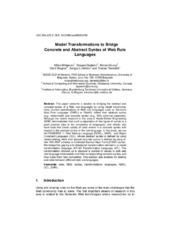Please use this identifier to cite or link to this item:
https://rfos.fon.bg.ac.rs/handle/123456789/522Full metadata record
| DC Field | Value | Language |
|---|---|---|
| dc.creator | Milanović, Milan | |
| dc.creator | Gašević, Dragan | |
| dc.creator | Giurca, Adrian | |
| dc.creator | Wagner, Gerd | |
| dc.creator | Lukichev, Sergey | |
| dc.creator | Devedžić, Vladan | |
| dc.date.accessioned | 2023-05-12T10:09:16Z | - |
| dc.date.available | 2023-05-12T10:09:16Z | - |
| dc.date.issued | 2009 | |
| dc.identifier.issn | 1820-0214 | |
| dc.identifier.uri | https://rfos.fon.bg.ac.rs/handle/123456789/522 | - |
| dc.description.abstract | This paper presents a solution to bridging the abstract and concrete syntax of a Web rule languages by using model transformations. Current specifications of Web rule languages such as Semantic Web Rule Language (SWRL) or RuleML define their abstract syntax (e.g., metamodel) and concrete syntax (e.g., XML schema) separately. Although the recent research in the area of Model-Driven Engineering (MDE) demonstrates that such a separation of two types of syntax is a good practice (due to the complexity of languages), one should also have tools that check validity of rules written in a concrete syntax with respect to the abstract syntax of the rule language. In this study, we use the REWERSE I1 Rule Markup Language (R2ML), SWRL, and Object Constraint Language (OCL), whose abstract syntax is defined by using metamodeling, while their textual concrete syntax is defined by using either XML/RDF schema or Extended Backus-Naur Form (EBNF) syntax. We bridge this gap by a bi-directional transformation defined in a model transformation language (ATLAS Transformation Language, ATL). This transformation allowed us to discover a number of issues in both web rule language metamodels and their corresponding concrete syntax, and thus make them fully compatible. This solution also enables for sharing web rules between different web rule languages. | en |
| dc.publisher | ComSIS Consortium | |
| dc.relation | Canada's NSERC | |
| dc.relation | European Commission | |
| dc.relation | Swiss State Secretariat for Education and Research | |
| dc.rights | openAccess | |
| dc.rights.uri | https://creativecommons.org/licenses/by-nc-nd/4.0/ | |
| dc.source | Computer Science and Information Systems / ComSIS | |
| dc.subject | transformations | en |
| dc.subject | syntax | en |
| dc.subject | SWRL | en |
| dc.subject | rules | en |
| dc.subject | R2ML | en |
| dc.subject | OCL | en |
| dc.subject | MDE | en |
| dc.subject | languages | en |
| dc.title | Model transformations to bridge concrete and abstract syntax of web rule languages | en |
| dc.type | article | |
| dc.rights.license | BY-NC-ND | |
| dc.citation.epage | 85 | |
| dc.citation.issue | 2 | |
| dc.citation.other | 6(2): 47-85 | |
| dc.citation.rank | M23 | |
| dc.citation.spage | 47 | |
| dc.citation.volume | 6 | |
| dc.identifier.doi | 10.2298/csis0902047M | |
| dc.identifier.fulltext | http://prototype2.rcub.bg.ac.rs/bitstream/id/1047/518.pdf | |
| dc.identifier.rcub | conv_1042 | |
| dc.identifier.scopus | 2-s2.0-77953850056 | |
| dc.identifier.wos | 000272897000003 | |
| dc.type.version | publishedVersion | |
| item.cerifentitytype | Publications | - |
| item.fulltext | With Fulltext | - |
| item.grantfulltext | open | - |
| item.openairetype | article | - |
| item.openairecristype | http://purl.org/coar/resource_type/c_18cf | - |
| Appears in Collections: | Radovi istraživača / Researchers’ publications | |
This item is licensed under a Creative Commons License


